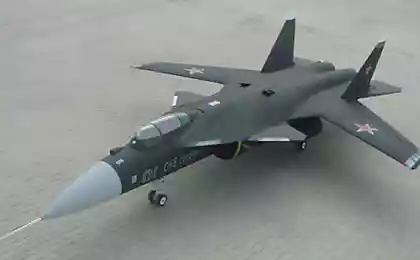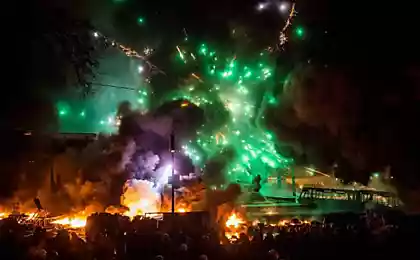678
With 37 "Berkut" (5 pictures, little letters)
With 37 "Berkut" (aka Su 47)
In the second half of the 70s. the Soviet Union initiated a scoping study on the program of the fifth generation fighter I-90. Under this program, considered and aircraft with forward-swept wing (CBS). The main advantages of this arrangement are:
* Significant increase in the aerodynamic qualities for maneuvering, especially at low speeds;
* Large lifting force compared to the wing straight sweep having the same area and, consequently, a large capacity (30%);
* Increase the range at subsonic flight regimes due to less trim drag:
* Better handling at low subsonic speeds (and, consequently, improve the field surgery);
* Improving the working conditions of the wing mechanization (which also reduces the take-off and landing distance);
* Lower stall speed;
* Improved antispin characteristics;
* An increase in the internal volume of the glider, particularly at the junction of the wing and fuselage, which provides the best conditions for the formation of internal gruzootseke. In 1980, Yakovlev Design Bureau. Sukhoi in cooperation with industry research centers began research project fighter with CBS. Work on it were conducted in parallel with investigations of fighters who have other aerodynamic layout.
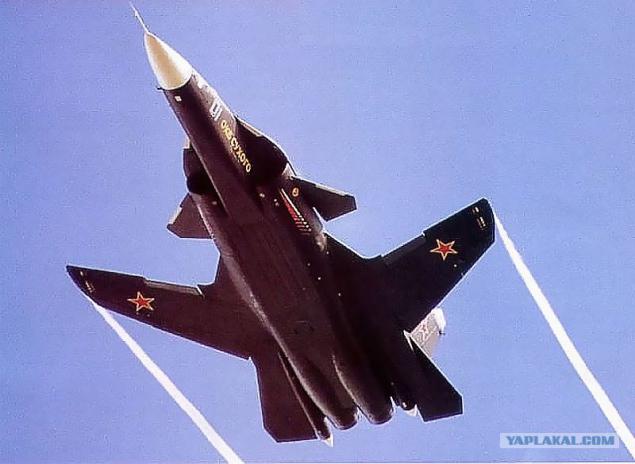
TTH:
Dimensions & Weight
Aircraft length, m (with LDPE) 22, 60
Height, m 6, 40
Wingspan, m 16, 7
Wing area, m 2 56 0
Takeoff Weight, OK 25670
maximum 34,000
Powerplant
Number of engines 2
The engine turbofan D-30F11
The engine thrust, kgf Maximal 2h9500
Furious 2h15600
Flight data (settlement)
The maximum speed, km / h (= M) at an altitude of 2200 (2, 1)
1400 near the ground (1, 12)
Service ceiling, m 18000
Practical range, 3,300 km
Maximum operating overload 9 0
Armament
Cannon GSH-301 (30mm)

History
In 1980, the Sukhoi Design Bureau in cooperation with industry research centers in the beginning of the research project fighter with CBS. Work on it were conducted in parallel with research on the fighters, having other aerodynamic layout. A contest was announced projects. According to the results of the Air Force chose multifunctional frontline fighter (IFIs) Mikoyan design bureau, made on a "duck" with a delta wing and canards developed. Selected for the highly maneuverable fighter Sukhoi layout (CBS and unregulated intake) resulted in a deterioration in comparison with the scheme MFI performance at supersonic speeds, which was due to the increase of drag and a large displacement of the aerodynamic focus.
When you create an aircraft with forward-swept wing arose and very complex problem of the elastic divergence wing. Attempts to increase the rigidity of the CBS with a traditional design, lead to an unacceptable increase in mass. However, in the 80s developed a method of combating divirgentsiey by a special arrangement of the axes of the stiffness of the wing (ie. E. Directed by torsion), rotation of the section of the compensating increase in angle of attack on the bend. The desired effect can be obtained by a special choice of directions of reinforcing strands composite wing.
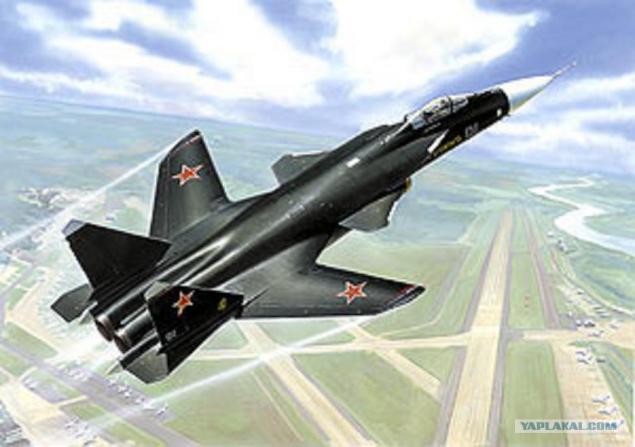
Although preference is given to the Air Force fighter project OKB. Mikoyan, Sukhoi Design Bureau to work on the plane with CBS continued. The credit is greatly M.P.Simonova chief designer, who managed to keep the promising theme contrary adverse "external circumstances". The specific contribution to the appearance of the fifth-generation fighter with CBS introduced and general designer of NPO "Star" G.I.Severin, proposed a fundamentally new concept ejection seat variable geometry, which provides the pilot the ability to conduct air combat maneuvering with much higher than in the previous fighters, Congestion. This allowed us to maximize the benefits of agile aircraft with a wing inverse strelovidnosti.Berkut
However, during the design of the aircraft revealed that the design of the machine peretyazhelena. This required a radical revision of the draft, in fact, the creation of a new fighter. Taking into account work experience and based on existing scientific and technological potential, the OKB im.P.O.Suhogo started to develop a new fighter with CBS, received an index «P.32».
In one embodiment, P.32 intended to equip two turbofan RD-79m (2 x 18.500 kg) with the thrust vector control system (upgraded version of the RD-79, created for the aircraft vertical takeoff and landing Yak-141). Later it was decided to establish on the fifth generation fighter engine AL-41F.
When creating the plane P32 serious attention was paid to reducing radolokatsionnoy visibility (in the field of OKB im.P.O.Suhogo has considerable experience gained during the development of heavy bombers, in particular - Aircraft T-4MS).
Initially, up to 1991, together with the Irkutsk aircraft plant to be built a few experimental machines (for flight and static tests). Later, when public funding program actually stopped and she gained the status of an "initiative", it was decided to build only one "pilot" machine, received index "S. 37 ". When "Compression" on ran- to loads not exceeding operating the aircraft to be used for flight testing. Modern methods of static tests allow to accurately estimate the strength of the design, not bringing it to destruction.

As a result, the program was able to significantly speed up and reduce its 37-stoimost.S
Due to the lack of "full-time" engine, it was decided as an interim measure to establish the machine two turbofan D-30F6 (2 x 15.600 kg), created for the MiG-31. In the future, the aircraft has to be re-equipped engine fifth-generation AL-41F (2 x 20.000 kg), provided with UHT. With new turbofan he will get the ability to make a long cruise at supersonic speeds without using afterburners.
Summer 1997 pilot demonstration aircraft, designated "P.37" and the name "Golden Eagle" was already on the territory of LII. Gromov in Zhukovsky. In September, we began high-speed taxiing, and only 25 of the same month a plane piloted by test pilot Igor Votintseva, made his pepvy flight. The first series of tests continued until the spring of 1998, after which the aircraft was delivered on completion. Later, flight tests resumed.
In 1999, P.37 aircraft was included in the state defense order, which should improve the funding for the program. Today, "Golden Eagle" is seen primarily as an experimental aircraft designed for flight testing of new technical solutions and demonstrate technologies (in particular means of reducing the visibility), as well as mining elements supermaneuverability. In the future, it should become a prototype highly maneuverable multipurpose fighter of the fifth generation.
Posted in [mergetime] 1227173848 [/ mergetime]
EVERYTHING! ..
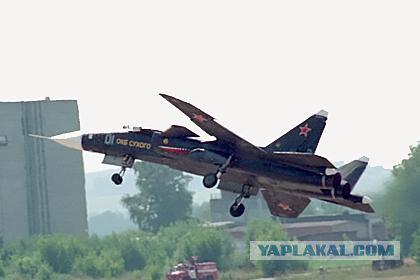
Source:
In the second half of the 70s. the Soviet Union initiated a scoping study on the program of the fifth generation fighter I-90. Under this program, considered and aircraft with forward-swept wing (CBS). The main advantages of this arrangement are:
* Significant increase in the aerodynamic qualities for maneuvering, especially at low speeds;
* Large lifting force compared to the wing straight sweep having the same area and, consequently, a large capacity (30%);
* Increase the range at subsonic flight regimes due to less trim drag:
* Better handling at low subsonic speeds (and, consequently, improve the field surgery);
* Improving the working conditions of the wing mechanization (which also reduces the take-off and landing distance);
* Lower stall speed;
* Improved antispin characteristics;
* An increase in the internal volume of the glider, particularly at the junction of the wing and fuselage, which provides the best conditions for the formation of internal gruzootseke. In 1980, Yakovlev Design Bureau. Sukhoi in cooperation with industry research centers began research project fighter with CBS. Work on it were conducted in parallel with investigations of fighters who have other aerodynamic layout.

TTH:
Dimensions & Weight
Aircraft length, m (with LDPE) 22, 60
Height, m 6, 40
Wingspan, m 16, 7
Wing area, m 2 56 0
Takeoff Weight, OK 25670
maximum 34,000
Powerplant
Number of engines 2
The engine turbofan D-30F11
The engine thrust, kgf Maximal 2h9500
Furious 2h15600
Flight data (settlement)
The maximum speed, km / h (= M) at an altitude of 2200 (2, 1)
1400 near the ground (1, 12)
Service ceiling, m 18000
Practical range, 3,300 km
Maximum operating overload 9 0
Armament
Cannon GSH-301 (30mm)

History
In 1980, the Sukhoi Design Bureau in cooperation with industry research centers in the beginning of the research project fighter with CBS. Work on it were conducted in parallel with research on the fighters, having other aerodynamic layout. A contest was announced projects. According to the results of the Air Force chose multifunctional frontline fighter (IFIs) Mikoyan design bureau, made on a "duck" with a delta wing and canards developed. Selected for the highly maneuverable fighter Sukhoi layout (CBS and unregulated intake) resulted in a deterioration in comparison with the scheme MFI performance at supersonic speeds, which was due to the increase of drag and a large displacement of the aerodynamic focus.
When you create an aircraft with forward-swept wing arose and very complex problem of the elastic divergence wing. Attempts to increase the rigidity of the CBS with a traditional design, lead to an unacceptable increase in mass. However, in the 80s developed a method of combating divirgentsiey by a special arrangement of the axes of the stiffness of the wing (ie. E. Directed by torsion), rotation of the section of the compensating increase in angle of attack on the bend. The desired effect can be obtained by a special choice of directions of reinforcing strands composite wing.

Although preference is given to the Air Force fighter project OKB. Mikoyan, Sukhoi Design Bureau to work on the plane with CBS continued. The credit is greatly M.P.Simonova chief designer, who managed to keep the promising theme contrary adverse "external circumstances". The specific contribution to the appearance of the fifth-generation fighter with CBS introduced and general designer of NPO "Star" G.I.Severin, proposed a fundamentally new concept ejection seat variable geometry, which provides the pilot the ability to conduct air combat maneuvering with much higher than in the previous fighters, Congestion. This allowed us to maximize the benefits of agile aircraft with a wing inverse strelovidnosti.Berkut
However, during the design of the aircraft revealed that the design of the machine peretyazhelena. This required a radical revision of the draft, in fact, the creation of a new fighter. Taking into account work experience and based on existing scientific and technological potential, the OKB im.P.O.Suhogo started to develop a new fighter with CBS, received an index «P.32».
In one embodiment, P.32 intended to equip two turbofan RD-79m (2 x 18.500 kg) with the thrust vector control system (upgraded version of the RD-79, created for the aircraft vertical takeoff and landing Yak-141). Later it was decided to establish on the fifth generation fighter engine AL-41F.
When creating the plane P32 serious attention was paid to reducing radolokatsionnoy visibility (in the field of OKB im.P.O.Suhogo has considerable experience gained during the development of heavy bombers, in particular - Aircraft T-4MS).
Initially, up to 1991, together with the Irkutsk aircraft plant to be built a few experimental machines (for flight and static tests). Later, when public funding program actually stopped and she gained the status of an "initiative", it was decided to build only one "pilot" machine, received index "S. 37 ". When "Compression" on ran- to loads not exceeding operating the aircraft to be used for flight testing. Modern methods of static tests allow to accurately estimate the strength of the design, not bringing it to destruction.

As a result, the program was able to significantly speed up and reduce its 37-stoimost.S
Due to the lack of "full-time" engine, it was decided as an interim measure to establish the machine two turbofan D-30F6 (2 x 15.600 kg), created for the MiG-31. In the future, the aircraft has to be re-equipped engine fifth-generation AL-41F (2 x 20.000 kg), provided with UHT. With new turbofan he will get the ability to make a long cruise at supersonic speeds without using afterburners.
Summer 1997 pilot demonstration aircraft, designated "P.37" and the name "Golden Eagle" was already on the territory of LII. Gromov in Zhukovsky. In September, we began high-speed taxiing, and only 25 of the same month a plane piloted by test pilot Igor Votintseva, made his pepvy flight. The first series of tests continued until the spring of 1998, after which the aircraft was delivered on completion. Later, flight tests resumed.
In 1999, P.37 aircraft was included in the state defense order, which should improve the funding for the program. Today, "Golden Eagle" is seen primarily as an experimental aircraft designed for flight testing of new technical solutions and demonstrate technologies (in particular means of reducing the visibility), as well as mining elements supermaneuverability. In the future, it should become a prototype highly maneuverable multipurpose fighter of the fifth generation.
Posted in [mergetime] 1227173848 [/ mergetime]
EVERYTHING! ..

Source:

